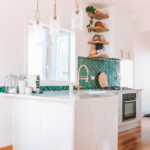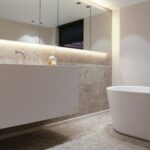Keeping your marble tabletops and furniture in pristine condition can be a challenge. But don’t worry, we’re here to help!
In this comprehensive guide, we’ll share with you the simplest and most effective methods to clean and care for your beloved marble pieces.
Say goodbye to stains and scratches, and say hello to beautifully maintained marble surfaces that will stand the test of time.
Key Takeaways
- Different cleaning methods, such as using warm water and mild soap, baking soda paste, commercial pH-neutral cleaners, or microfiber cloths, can effectively remove stains and dirt from marble surfaces.
- When cleaning, use a soft cloth or sponge to avoid scratching the surface. Gently wipe the marble in a circular motion, paying attention to areas prone to stains or spills. Rinse thoroughly with clean water and use a dry cloth for drying to prevent water spots.
- Avoid placing hot or acidic substances directly on the surface, as they can cause etching or discoloration. Always use coasters, trivets, or placemats to provide a barrier between the marble and any potentially harmful materials.
- Investing in protective measures, such as applying a sealant or wax, can also help maintain the beauty of your marble pieces.
- Proper care and maintenance of marble tabletops and furniture is crucial for their durability, aesthetics, hygiene, and resale value.
Cleaning Marble Tabletops: How To Effectively Remove Stains From Marble Surfaces
Cleaning your marble table tops is important to maintain their beauty and durability. Fortunately, there are several options available to effectively clean and remove stains from your marble surfaces.
Warm water and mild soap
You can use regular soap and water to clean a marble tabletop with ease. To start, mix a small amount of mild dish soap or a marble-specific cleaner with warm water.
This gentle cleaning solution will effectively remove dirt and grime without harming your delicate marble surface.
Take a damp cloth and dip it into the cleaning solution, making sure it’s not too wet. Gently scrub the marble table top, paying extra attention to any dirty areas.
Avoid applying too much pressure to prevent scratches. Once you’ve cleaned the entire surface, rinse the cloth with clean water and wipe down the table top to remove any soap residue.
To finish, dry the marble table top with a clean towel to prevent water spots or streaks. Remember, regular cleaning with warm water and mild soap is an essential part of caring for your marble table tops and ensuring they remain beautiful for years to come.
Baking soda paste
Cleaning marble table tops can be done easily using a homemade baking soda paste. This paste is great for removing stains, etches, spills, and scratches from your marble countertop or table top.
To make the baking soda paste, just mix equal parts baking soda and water to create a thick paste.
Once you have the paste, apply it directly to the affected area on your marble table top. Let it sit for a few minutes to allow the paste to penetrate the surface.
After that, gently scrub the area using a soft cloth or sponge. Remember to be gentle and avoid applying too much pressure, as this can scratch the marble.
Once you have finished scrubbing, rinse the area with clean water and dry it with a clean towel. You’ll be amazed at how clean and restored your marble table tops will look after using this baking soda paste. It’s an affordable and effective solution to keep your marble surfaces in top condition.
Commercial pH-neutral cleaners
To effectively and safely clean your marble tabletop, it is recommended to use pH-neutral cleaners specifically designed for marble.
These cleaners are easy to use and help remove stubborn stains without causing any damage. By using a pH-neutral cleaner, you can maintain the natural pH level of your marble, preventing any adverse reactions.
To clean your tabletop, dilute the cleaner according to the instructions and test it on a small, hidden area first.
Apply the cleaner using a soft cloth or sponge, working in small sections. For tough stains, let the cleaner sit for a few minutes before gently scrubbing.
Rinse off the cleaner thoroughly with a damp cloth, and then dry the surface to prevent any streaks or marks.
Microfiber cloth
Microfiber cloths are great for cleaning marble tabletops because they soak up dirt, don’t scratch the surface, and leave no lint behind. They are also reusable and durable, which is good for the environment.
To use a microfiber cloth, ensure that the marble surface is free of any loose debris by giving it a gentle dusting with a dry microfiber cloth.
Next, dampen the cloth with warm water and wring out any excess moisture. Gently wipe the tabletop in circular motions, ensuring that you cover the entire surface area.
Avoid using any harsh chemicals or abrasive cleaners as they can damage the marble. If necessary, you can use a mild pH-neutral detergent specifically formulated for marble.
Rinse the cloth with clean water and continue wiping the marble until all dirt and residue is removed. Once done, dry the tabletop thoroughly with a dry microfiber cloth to prevent water spots or streaks. Regular maintenance with microfiber cloth will help maintain the shine and beauty of your marble tabletop.

How To Take Care of Your Marble Tabletops and Other Marble Furniture
Caring for your marble table tops is essential to maintain their beauty and longevity. Here are some simple tips to help you keep your marble tables in great condition.
First, clean up spills immediately to prevent stains. Marble is porous, so any liquid left on the surface can seep in and leave a permanent mark.
Use a soft, damp cloth to wipe up spills right away, avoiding abrasive cleaners or scrubbing vigorously, as this can harm the marble.
To protect your marble table tops from scratches and cracks, it’s best to avoid placing heavy objects and using sharp utensils directly on the surface.
Use coasters, placemats, and trivets to provide a barrier between your table top and potentially damaging items.
Regularly dusting your marble table tops also helps in preventing scratches and maintain their shine. Use a soft, lint-free cloth or microfiber duster to gently remove dust and dirt.
Applying a marble sealer is also recommended. Sealing your marble helps protect it from spills and stains. Follow the manufacturer’s instructions for application and reapplication to ensure maximum protection.
Avoid placing your marble table tops in direct sunlight, as prolonged exposure can cause discoloration and fading. If your tables are near windows, use window treatments to filter out harmful UV rays.
Finally, to prevent scratching and scuffing, place felt pads on the bottom of decorative objects and other items that sit on your marble table tops. This will help protect both the surface and the items placed on it.
Why Should You Protect Your Marble Tabletops and Furniture From Deep Stains and Scratches?
Caring for your marble table tops and furniture is crucial to maintain their beauty and durability. Marble is a natural stone that can easily get stained and etched due to its porous nature.

There are several reasons why you should care for your marble tabletops and furniture:
Durability
Marble is a natural stone that is known for its durability and longevity. Proper cleaning and maintenance can help preserve the beauty and functionality of your marble furniture and ensure that it lasts for many years.
Aesthetics
Marble is a highly prized material for its unique and elegant appearance. Regular care will help keep your marble tabletops and furniture looking polished and beautiful, enhancing the overall aesthetic appeal of your home or office space.
Investment
Marble furniture is often considered a valuable investment due to its high cost. By taking care of your marble tabletops and furniture, you are protecting your investment and ensuring its value remains intact.
Stain resistance
Marble is naturally porous, making it susceptible to stains from spills and substances such as red wine, oil, or acidic liquids. Proper care and sealing can help prevent staining and keep your marble furniture looking clean and spotless.
Hygiene
Marble surfaces can harbor bacteria, allergens, and germs if not properly cleaned and maintained. Regular care ensures that your marble furniture remains hygienic and safe for use.
Longevity
Marble furniture requires a certain level of care and maintenance to maintain its longevity. By following proper cleaning and maintenance practices, you can prolong the lifespan of your marble tabletops and furniture.
Resale value
If you plan to sell your marble furniture in the future, well-maintained pieces can fetch higher prices and attract potential buyers.
Things That Can Harm Your Marble Table Tops and Furniture

Taking proper care of your marble tabletops, countertops and other furniture is essential, and being aware of what can harm them is crucial.
Acidic substances
Marble is sensitive to acidic substances such as lemon juice, vinegar, and certain cleaning products. These can cause etching or dulling of the surface.
Heat
Placing hot objects directly on marble can cause thermal shock and lead to cracks or discoloration. Always use coasters or trivets to protect the surface.
Scratches
Marble is a relatively soft stone and can be easily scratched by sharp objects or abrasive materials. Avoid dragging heavy items across the surface and use protective pads or mats under objects.
Stains
Marble is porous and can absorb liquids, leading to stains. It is important to clean up spills immediately to prevent them from penetrating the surface. Avoid using colored liquids or substances that can leave stains.
Harsh cleaning products
Using harsh chemicals or abrasive cleaners can damage the protective sealant on marble and cause discoloration or etching. Stick to mild, pH-neutral cleaners specifically designed for marble.
Direct sunlight
Prolonged exposure to direct sunlight can cause fading or discoloration of marble. Use curtains or blinds to protect your marble furniture from excessive sunlight.
Water damage
Excessive moisture or water can seep into the pores of marble and cause damage over time. Avoid placing wet items directly on marble surfaces and wipe up any spills promptly.
Heavy impact
Dropping or banging heavy objects on marble can cause chips or cracks. Be cautious when moving or handling heavy items around marble furniture.
Improper maintenance
Neglecting regular cleaning and maintenance can lead to the accumulation of dirt, grime, and stains on marble surfaces. Follow proper cleaning and maintenance guidelines to keep your marble furniture in good condition.
Natural wear and tear
Over time, marble can develop natural wear and tear, including small scratches, dullness, or minor chips. Regular maintenance and occasional professional polishing can help restore the original beauty of marble furniture.
How Stone Protection Can Help You Clean and Care for your Marble Tabletops
If your marble table tops and furniture have lost their shine, Stone Protection can help clean and restore them back to their glorious shine.
They specialize in marble cleaning, restoration and maintenance. They also offer services for other surfaces like granite and concrete.
They assess each surface’s needs and provide the right treatments, such as removing scratches or sealing surfaces.
They also offer advice on how to care for your surfaces between treatments. Trust Stone Protection to bring back the shine and keep your surfaces looking great.
Frequently Asked Questions
Should you polish marble wet or dry?
Marble should be polished wet. Wet polishing helps to reduce heat and friction, preventing damage to the marble surface. Additionally, water acts as a lubricant, allowing for a smoother and more effective polishing process.
Can you wax a marble tabletop?
No, you should not wax a marble tabletop. Wax can create a sticky residue and damage the natural beauty of marble. Instead, use a marble-specific cleaner and polish to maintain its shine.
Can you use toothpaste to polish marble table tops?
Yes, toothpaste can be used to polish marble. Its mild abrasive properties can help remove stains and gently buff the surface of the marble.
Can I use sandpaper to polish marble table tops?
No, using sandpaper to polish marble table tops is not recommended. Sandpaper is abrasive and can scratch the surface of the marble, rather than polishing it. It is best to use specific marble polishing products or consult a professional for optimal results.
What stains marble the most?
Acidic substances such as lemon juice, vinegar, or certain cleaning products can stain marble the most. These substances can react with the porous surface of the marble and cause discoloration or etching.
Are there any stains that can’t be removed from marble?
Yes, there are certain types of stains that can be extremely difficult or impossible to remove from marble surfaces. These include permanent markers, deep-set oil stains, and certain types of acid etching. Take immediate action when any spill occurs to prevent permanent damage.





